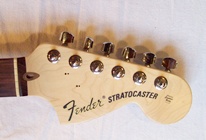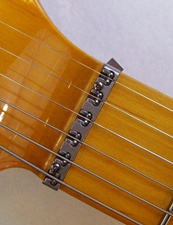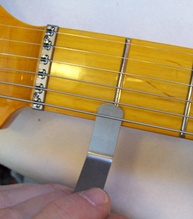|
Guitar nut and Tuners
Checking out your guitar nut, and tuners is the first step to guitar maintenance, and setup. I'll probably blab on ad nausium about how important it is to do guitar setup in the order I've laid out. 
In the photo to the left is a typical stratocaster headstock. You want to make sure, before doing anything else, that your guitar tuners, and string tees, are held in position tight. The tuners shown have no screws in the back holding them in place, so I can simply check with a wrench to make sure they're tight. If you have screws on the back of the headstock holding the tuners in place, make sure they're seated well. Do not perform this with the strings taught, if your guitar is strung up, slacken the strings first, before tightening anything. Adjust the tension which is needed to turn the tuners. On these particular tuners, there are flat head screws on each tuner finger hold, that allow for adjustment. You want to feel some tension when turning the tuners. Not vice grip tension mind you, but not wing nut loose either, a happy medium. 
once you've got the headstock all secure and adjusted it's time to check out the nut. To the right is a Fender roller nut, the best invention since sliced bread in my book. But most nuts are plastic, bone, graphite, or some other type of material. Now I know for some of you it's uncomfortable talking about nuts, but nuts are important, and over time they wear out. Especially the nuts on the persistent dive bomber guitars. Get your hands on a set of automotive feeler gauges. With your guitar in tune fret each string between the second and third fret one at a time. Measure the distance between the bottom of the string, and the top of the first fret wire. Start with a .005 inch feeler gauge. If any of the strings are below .005 inches, it's time for a new guitar nut, unless you've got a Fender roller nut witch you can shim. 
Replacing a guitar nut is real easy, they are glued in place with a small dab of glue, unless some brain surgeon has been at the guitar before with a gallon of gorilla glue. By chance if the nut sits too high, which is really quite a suggestive measurement, you can purchase a set of luthier nut files that will fit each string slot with precision. If your nuts good, move on to step two.
return from Check your guitar nut to Electric Guitar Info home |




